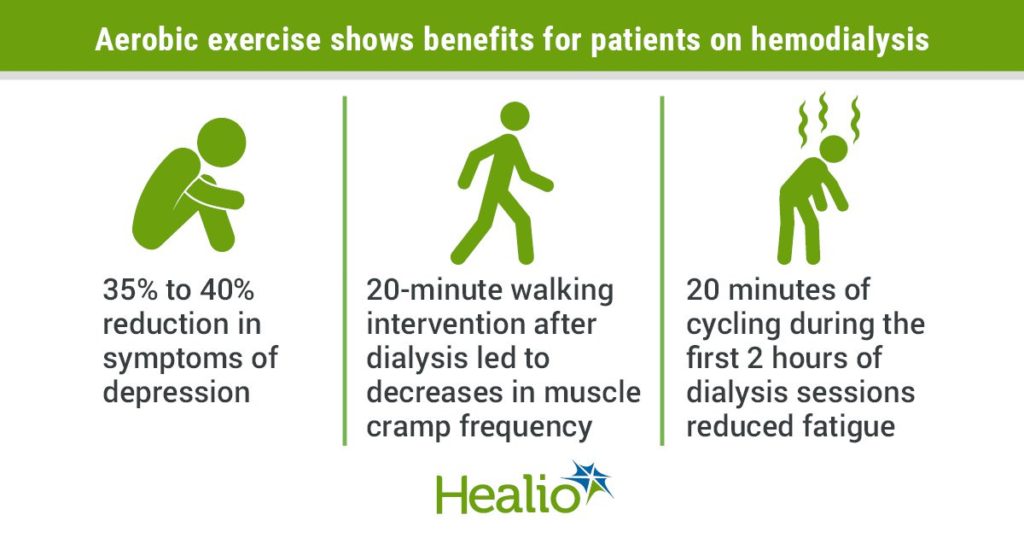March 26, 2021
2 min read
Source/Disclosures
Published by:
Disclosures:
Bohm reports ownership interest in Precision Advanced Digital Manufacturing, research funding from Hope Pharmaceuticals and support from the Manitoba Medical Services Foundation. Hargrove reports support from the Kidney Foundation of Canada, Manitoba Branch and the Kenneth and Elizabeth Walton Research Scholarship in Medicine, University of Manitoba. Please see the study for all author authors’ relevant financial disclosures.
A review of randomized controlled trials found aerobic exercise played a role in improving a variety of hemodialysis-related symptoms, including a reduction of up to 40% in depressive symptoms.
“Evidence from small randomized controlled trials (RCTs) suggests that aerobic exercise can improve [hemodialysis] HD-related symptoms, such as [restless leg syndrome] RLS, sleep disturbance, muscle cramping, and symptoms of depression,” Nicholas Hargrove, BSc, MD, of the University of Manitoba in Canada, and colleagues, wrote. “Although not all studies have shown benefits of exercise on symptom burden, a recent prioritization study identified exercise as a potential therapeutic intervention in HD worthy of further study.”

Infographic content was derived from Hargrove N, et al. Clin J Am Soc Nephrol. 2021;doi:10.2215/CJN.15080920.
To investigate, the researchers included 15 randomized controlled trials that examined aerobic exercise as an intervention to reduce a variety of symptoms: nine studies considered the impact of aerobic exercise on depression, four were on sleep disturbance, two were on restless legs syndrome, one was on muscle cramping and one was on fatigue. Researchers noted the intervention was performed outside of the hemodialysis session in five of the studies, while it was performed during the session in the remaining 10.
The meta-analysis revealed that, when compared with “non-exercise controls,” aerobic exercise was associated with an improvement in restless legs syndrome, symptoms of depression, muscle cramping and fatigue.
More specifically, both studies looking at restless leg syndrome found aerobic exercise contributed to a decrease in the International Restless Legs Syndrome Study Group Severity Scale from baseline, while the study comparing a 20-minute walking intervention after dialysis (twice weekly) led to decreased muscle cramp frequency (83% of participants in intervention saw improvements vs. 31% in the control group).
Regarding depression, researchers found seven of the nine randomized controlled trials showed aerobic exercise led to a significant improvement in depressive symptoms compared with control groups; in the three that considered the Beck Depression Inventory as an outcome, participants in the intervention had greater reductions in scores from baseline (mean difference between intervention and control of 7.57).
“The 35% [to] 40% reduction in symptoms of depression observed with aerobic exercise compared with usual care in the majority of included studies is encouraging and consistent with a clinically important difference,” Hargrove and colleagues wrote. “Considering the high prevalence of depressive symptoms in individuals receiving HD and their reluctance to accept pharmacological treatment for depression, the development of effective nonpharmacological treatments is imperative.”
Lastly, the study examining the impact of aerobic exercise on fatigue (20 minutes of cycling during the first 2 hours of dialysis sessions) found the intervention group had greater decreases in Multidimensional Fatigue Inventory after 3 months compared with controls (-4.6 vs. 7).
“Although fatigue has been identified as a priority outcome for future studies in the HD population, we found only a single RCT that investigated the effect of aerobic exercise on this symptom, highlighting the need for further research,” the researchers wrote.
Co-investigator on the study, Clara Bohm, MD, MPH, commented on additional areas to explore that could help illuminate how aerobic exercise might benefit patients receiving hemodialysis.
“Future studies need to include people with diverse characteristics, particularly more women, elderly individuals, and people with low functional status, to see if exercise has similar effects,” she said in a related press release. “Also, it is still not clear what exercise intensity and duration are required to see benefits, and if there is a different effect with different types and location of exercise, such as exercise performed during dialysis treatment or outside of dialysis.”
